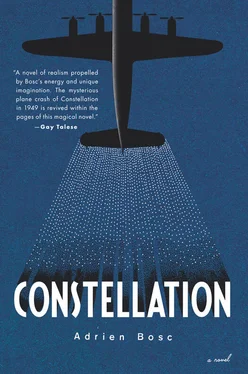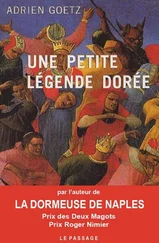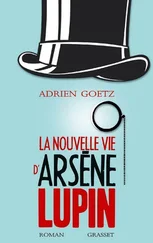The Phoney War was under way, René volunteered for a mission in the Balkans. Nothing is known of this journey. As a good spy, he asked his wife, Marguerite, to burn every scrap of documentary evidence before his departure. The French Army signed an armistice on June 17, marking the end of his mission as a double agent. In early July, he arranged to meet his wife and brother in Lyon and told them he was leaving for the United States, where he would try to enlist with the Free French Forces. His family would stay in Alsace, in his brother’s keeping. For five years he tried by every possible means to join the Allied intelligence services: being from Alsace proved an obstacle. And so, he lived a double life. He haunted the waiting rooms of officialdom, settled, bought a house, and finally managed to contribute to the American espionage services — deciphering code, translating, radio jamming, low-level tasks far from the secrets of Enigma.
On May 8, 1945, the war over, René took the first available ship to France. His one thought was to convince his wife to immigrate to the United States while he found work as a foreign correspondent for Combat or l’Aurore . The conversation went nowhere, out of the question, she had been waiting five years for him, he would abandon his dream of America immediately and resume his place as managing editor of Dernières nouvelles d’Alsace , at 17 rue de la Nuée-Bleue. In October 1949, resigned to life in Alsace, he decides to sell the house in New York. A last few details require his presence there. On October 27, aboard Air France’s F-BAZN, René Hauth puts an end to his American dream.

In November, an Air France employee calls the Hauth residence. René’s widow answers, they explain the situation to her: the body of her husband has not been identified, does she want him buried in a communal crypt at Père-Lachaise or does she want an empty coffin sent back to Alsace? Her brother-in-law is listening to the conversation. It’s out of the question for René to be one of the dead with no grave. His cousin René Fontaine, a medical school professor, would be able to identify Hauth and offers to visit the mortuary on boulevard Richard-Lenoir, accompanied by the dead man’s dentist. They identify his body within minutes — without the benefit of science, searching the pockets of one of the anonymous corpses, they find René’s passport. No wedding ring. Had he been robbed of it by looters on the mountainside? Horrible rumors were circulating, stories of fingers being chopped off. On their return, Marguerite reassures them. René often played golf, and as the ring bothered him, they had an agreement that she would wear both.
26. Symphony for Solo Plane
Machines create such a large number and variety of noises that pure sound, because of its weakness and monotony, no longer elicits any emotion.
— Luigi Russolo, The Art of Noise
On October 5, 1949, the first work by Pierre Schaeffer, Five Studies of Noises , is broadcast on French television. A “concert of noises” comprising five pieces: “Disconcerting, or Study with Automatic Sprinklers”; “Imposed, or Study with Railroad”; “Concertante, or Study for Orchestra”; “Composed, or Piano Study”; “Pathétique, or Study with Pots.” Together with Pierre Henry, Schaeffer founds the Group for Concrete Music Research (GRMC), and together they record the two-record Symphony for Solo Man . Two parts of the work bear the title “Prosopopoeia.” Their research focuses on arranging noises, composing with concrete elements derived from the real world that, laid end to end, will form a continuous sound, music. In December 1949, at the very moment when Constellation F-BAZO is in the air mimicking the tragic flight of Air France’s F-BAZN to try to uncover some of the factors, Pierre Schaeffer formalizes his art of noise in the journal Polyphonie , calling it “concrete music.” In this manifesto on animate sound, he writes: “This practice of composing with elements sampled from available experimental sounds I intentionally name ‘Concrete Music,’ to signal our dependence, not on preconceived abstract sounds, but on sound fragments that exist concretely, taken as definite and integral sound objects.” You might say, What relation does this have to the story of the airplane downed in the Azores and the re-creation of its flight by Air France’s investigative unit? I answer, Not much really, except a certain kinship and, looking back and noting strange correspondences, the synchronicity of certain dates. In line with Pierre Schaeffer’s “Study with Railroad” — a recording of steam locomotives — the section of the flight re-created by F-BAZO during the night of December 7 to 8, 1949, could have been called “Study with Flight Plan.” The French aviation inspectors traveling in the Constellation’s chromed tube are looking for sounds — discordant, continuous, or absent — they track noise and the breakdown of noise, they are radiophonic technicians. You doubt this, you find the comparison overblown, yet the job of these men is to strain to hear, huddled in an airframe over the Atlantic, the radio-electric guidance mechanisms strung in a line, like Tom Thumb’s pebbles, as beacons along the southern route to America. To hear this aeronautical music, you need to know your music theory. The flight of the investigating commission will give us a fine opportunity to practice our scales. Its primary mission is to ensure, as it flies the exact route of the downed aircraft, the good working order of the navigational signals and radio beacons all along the line between Orly and Santa Maria. A radio beacon, as its name suggests, broadcasts from a known location, allowing a ship or aircraft to calculate its position relative to the beacon on the earth’s surface, using a radio-electric guidance system known as a “sonic road.” A series of radio beacons can be used to trace lines on a chart whose intersection marks the receiver’s exact location.
+
The paths thus traced virtually in the sky compose a sonar signal linked by long distances to the transmitting beacons on the ground. Their carrying range depends on weather conditions — during a storm, for instance, the signal is weaker. How does this sound map manifest itself inside the plane? It’s fairly simple: if the aircraft drifts to the right of the traced route, the radio operator hears a series of long sounds, called “dashes”; if it drifts to the left, he hears a series of short sounds, called “dots”; and, of course, when the pilot keeps the plane flying within the airway determined by the transmitters on the ground, the dots and dashes meld to form an uninterrupted tone. In the case of Constellation F-BAZN, the fact that it crashed into Mount Redondo testifies that it drifted considerably off course. Why did the flight deviate north in the archipelago, and why was the crew not warned by the control tower at Santa Maria during the landing protocol a few minutes before impact? This is what the civil aviation inspectors are going to try to find out during the simulation.

After stopping in Madrid and Lisbon, Jean Dabry, the pilot of Constellation F-BAZO, heads for the archipelago and, at the Azores intersection, picks up the fatal route taken by his predecessor.
27. The Forty-Ninth Victim of the Constellation
Each loss, each passing of a beloved singer or artist, ineluctably became an occasion for national mourning.
— Stefan Zweig, The World of Yesterday
The first time Margarête Froehmel heard Ginette Neveu’s playing at an international competition in Vienna in 1931, it was a revelation. She was moved to tears by this girl of twelve, whose Bach Chaconne stood out from her competitors’, most of them adults. Since then, Margarête had not missed one of the virtuoso’s tours through Austria, and she methodically clipped any news accounts of her in the papers. Her big scrapbook contained articles about the Wieniawski Competition prize in March 1935, Ginette’s concerts in Germany, and her tours to the Soviet Union and the United States. A matted photograph of Ginette decorated the leather cover of the scrapbook, which was as meticulously bound as the books Margarête looked after in the municipal library for Vienna’s ninth borough. She was the library director. Her husband had died on the Russian front, conscripted into the Wehrmacht two years after the Anschluss. The library had been partially destroyed during the siege of Vienna in April 1945. The arrival of the Red Army on April 13 marked the end of Nazi occupation. The capital was just a field of ruins, and the sight of Russian soldiers filing in for three whole days had traumatized the population.
Читать дальше













